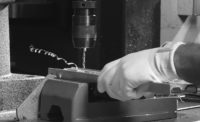
Buying a pair of gloves is usually considered to be no big deal. But if you’re a safety officer required to provide hand protection for numerous employees against specific or even multiple hazards, your job has become considerably more difficult in the past few years.
A combination of factors, from changes in industry standards to international trade agreements and overseas production, has opened the U.S. market to a flood of new products, making choice more complicated. New materials and production technologies have also added to the mix. Moreover, inadequate requirements for product testing and general pressure to reduce costs have left safety pros questioning how they can choose the best balance of protection and cost for their particular application.
Interesting times
A new standard for hand protection, the CE Standard developed within the European Standard EN 420 for PPE, may provide some positive direction, but in order to put it in context we need to take a closer look at the situation in the U.S.The past few years have been quite interesting in the U.S. glove industry. Traditionally, this industry has consisted of a collection of privately owned companies that tended to specialize in certain product technologies, like knitting, dipping, or cutting and sewing. Today that environment is very different. Over the past five to ten years trade agreements and regulations like NAFTA and the WTO Agreement to include China have opened up the barriers to imported products and have dramatically influenced the U.S. industry. In addition, most glove production has moved out of the U.S. as a result of pressure to make lower-cost products. Some of the biggest glove manufacturers are now part of larger publicly traded companies. These organizations have a more global view than ever before, and instead of specializing in certain product categories, they tend to provide a full array of hand protection products, including string knits (coated and uncoated, domestic and imported), flat dipped, chemical, cut resistant, sleeves, cut and sewn products, metal mesh, and more.
Advances in technology have also played a role, leading to new glove materials that can now provide, for example, high levels of cut resistance in a thin, flexible glove. Other new materials provide high levels of arc-flash protection, and while some gloves are labeled to reflect these levels of protection (per the NFPA 70E Standard), others are not.
As a result, there are literally thousands of glove styles available on the market today, each with a specific benefit that can be applied to different applications within the user’s operation.
What’s adequate?
With this vast proliferation of products on the market today, the safety pro — the decision-maker in selecting what types of hand protection workers should use — has a huge task. Despite these market dynamics, there has been little change in the way users in the U.S. market select hand protection products. OSHA 1910 says the employer must provide adequate protection for the user, but does not define exactly what adequate protection means. OSHA provides only minimal requirements for the selection of hand protection.A standard does exist for the U.S. market — ANSI Standard 105 for Hand Protection Selection Criteria — which defines the tests used to determine the levels of protection for cut, puncture, chemical and heat resistance, etc. Test results can then be correlated with various levels of protection. For example, ASTM F1790-97 specifies the test for cut resistance and defines five levels of protection. These tests provide a benchmark on the amount of protection offered by select hand protection products.
However, in the U.S. market, glove manufacturers are not required to provide this type of testing on all products, so not all manufacturers test their products or make results available. Additionally, the ANSI 105 standard is relatively new, so the marketplace is not yet generally familiar with the tests or how to apply the results. Very often, it seems, OSHA requirements and the application of standards tend to get trumped by price and cost savings, which U.S. operations need to stay competitive.
Thus, there are many questions regarding how safety pros or companies in general are supposed to narrow the choice of hand protection products and find the correct balance of protection versus cost for a particular operation. Given that the selection process is such an individual matter from operation to operation, how can management be assured that the best decision is being made for hand protection?

Figure 1. Under the new European CE Standard, gloves carry a CE marking and a pictogram indicating which risks the glove was tested against. Various pictograms represent testing for chemicals, microorganisms, mechanical, heat, cold, impact, cut, static electricity and radiation.
Across the pond
The Europeans and the EU have made great strides in answering these questions with EN420 for PPE and the CE Standard for hand protection. Under this standard, each glove and its packaging carries a CE marking and a pictogram indicating which risk the glove was tested against (see Figure 1), along with the manufacturer’s name and product size. Various pictograms represent testing for chemicals, microorganisms, mechanical, heat, cold, impact, cut, static electricity and radiation. Furthermore, mechanical risk markings provide a set of four numbers that represent the level of protection for abrasion, cut, tear and puncture resistance, respectively. For example, as shown in Table 1, a glove or product marked with a mechanical resistance of 4 3 4 2 means this particular glove provides level four abrasion resistance, level three cut resistance, level four tear resistance, and level two puncture resistance.Glove users and buyers can easily see the level of protection provided and use this information as a reference to select appropriate hand protection. Specific applications may require different levels of protection from industry to industry and even from company to company. Products marked with universal codes provide a basis for safety professionals and users alike to start comparing and contrasting different products. The CE Standard governs all hand protection products available in Europe and without these markings and test results, the gloves cannot enter the marketplace.
Some in the U.S. may think a government regulation like this might lead to an uncompetitive marketplace, while others argue it would make for a more educated and knowledgeable end-user or safety professional.

Table 1. Performance levels for mechanical hazards compliant with the EN420 standard
A benchmark
While a “CE-type†standard in the U.S. is certainly not the solution to all our hand protection issues, it is a step in the right direction in that it would help ensure that makers provide information on the quality and performance levels of their products, regardless of where they are manufactured. At the very least it would provide a benchmark for the industry in developing products and be helpful for end-users in selecting hand protection.And while a standard of this type should not replace the evaluation of individual applications or the advice of hand protection experts and specialists, it could provide an objective reference for the selection process.

